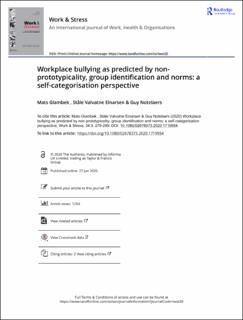| dc.contributor.author | Glambek, Mats | |
| dc.contributor.author | Einarsen, Ståle | |
| dc.contributor.author | Notelaers, Guy | |
| dc.date.accessioned | 2021-05-06T08:28:18Z | |
| dc.date.available | 2021-05-06T08:28:18Z | |
| dc.date.created | 2020-10-05T16:09:11Z | |
| dc.date.issued | 2020 | |
| dc.Published | Work & Stress. 2020, 34 (3), 279-299. | |
| dc.identifier.issn | 0267-8373 | |
| dc.identifier.uri | https://hdl.handle.net/11250/2753832 | |
| dc.description.abstract | Research and theory on deviance in work groups suggest that non-prototypical members risk devaluation and mistreatment by their peers. Drawing on the self-categorisation theory, we propose and test a contextual model to explain workplace bullying from a target perspective, using non-prototypicality as a predictor and social identification and anti-bullying norms at the work group level as two- and three-way cross-level moderators. Multilevel modelling and a sample of employees from the university sector in the Low Lands (n = 572) was employed. In line with our first hypothesis, we found that risk of exposure to workplace bullying is particularly high for non-prototypical work group members. We also hypothesised that work group social identification would facilitate bullying of non-prototypical members, while anti-bullying norms would buffer it. Results showed, however, that both conditions acted as buffering moderators on the main association. Lastly, the combination of the two also entailed a cross-level three-way interaction effect, showing that non-prototypicality is associated with bullying only in work groups characterised by low levels on both moderators. These novel and partly unexpected results demonstrate the relevance and significance of group level explanations for workplace bullying, holding significant implications for scholars and practitioners. | en_US |
| dc.language.iso | eng | en_US |
| dc.publisher | Taylor & Francis | en_US |
| dc.rights | Navngivelse 4.0 Internasjonal | * |
| dc.rights.uri | http://creativecommons.org/licenses/by/4.0/deed.no | * |
| dc.title | Workplace bullying as predicted by non-prototypicality, group identification and norms: a self-categorisation perspective | en_US |
| dc.type | Journal article | en_US |
| dc.type | Peer reviewed | en_US |
| dc.description.version | publishedVersion | en_US |
| dc.rights.holder | Copyright 2020 The Authors | en_US |
| cristin.ispublished | true | |
| cristin.fulltext | original | |
| cristin.qualitycode | 2 | |
| dc.identifier.doi | 10.1080/02678373.2020.1719554 | |
| dc.identifier.cristin | 1837248 | |
| dc.source.journal | Work & Stress | en_US |
| dc.source.40 | 34 | |
| dc.source.14 | 3 | |
| dc.source.pagenumber | 279-299 | en_US |
| dc.relation.project | Norges forskningsråd: 250127 | en_US |
| dc.identifier.citation | Work & Stress. 2020, 34(3), 279-299 | en_US |
| dc.source.volume | 34 | en_US |
| dc.source.issue | 3 | en_US |

